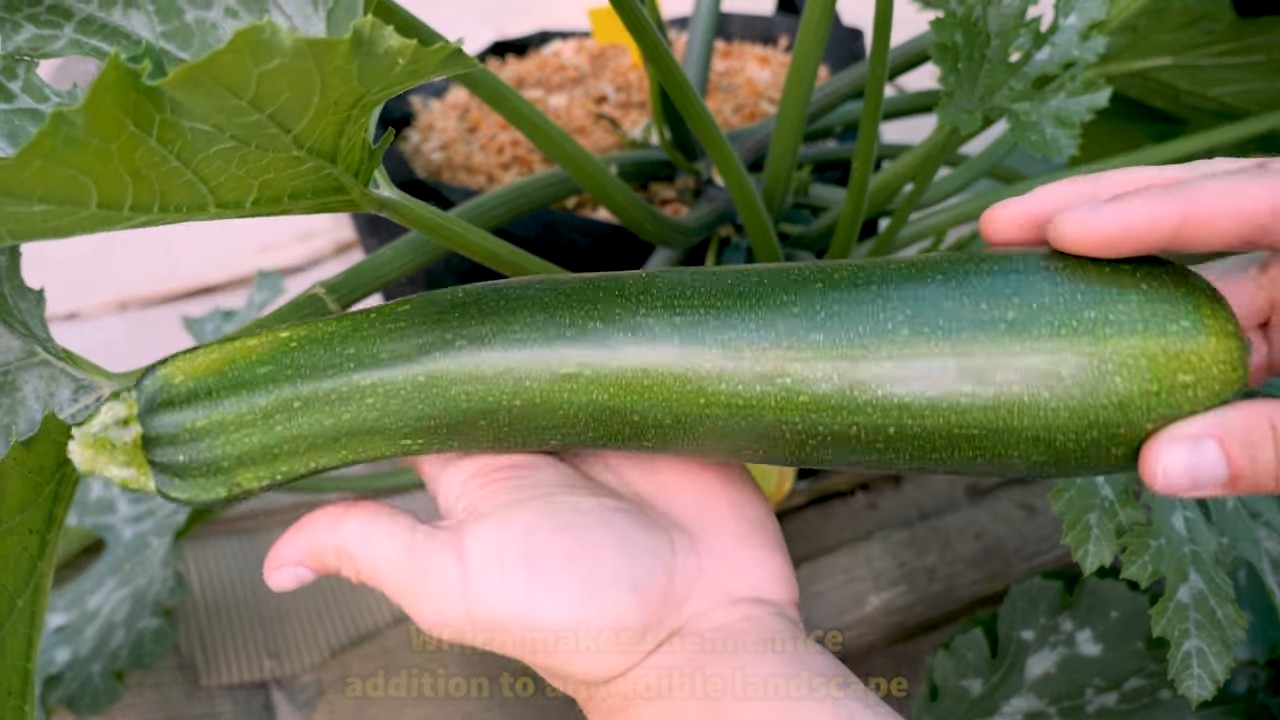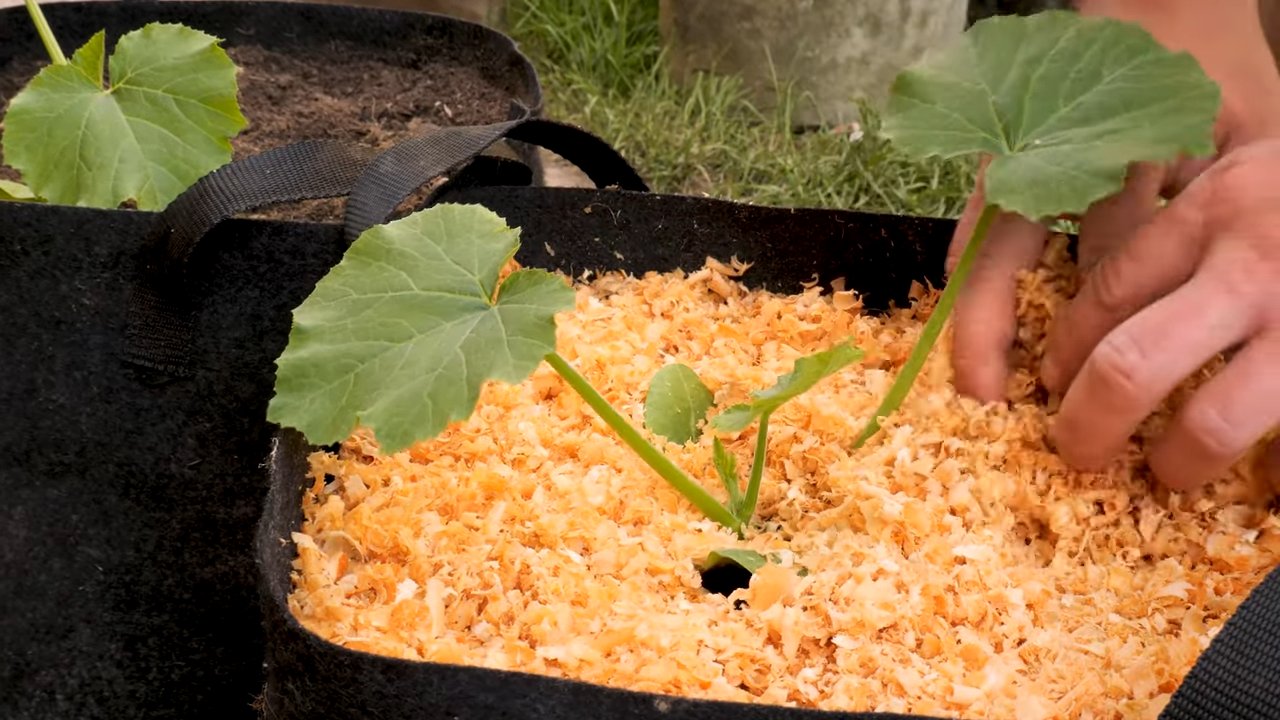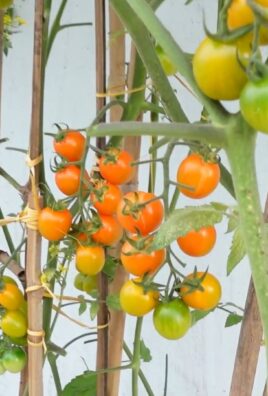Zucchini growing tips for beginners can feel overwhelming, but trust me, it doesn’t have to be! Imagine stepping into your backyard and harvesting fresh, vibrant zucchini, ready to be transformed into delicious meals. Sounds dreamy, right? Well, it’s totally achievable, even if you’ve never grown anything before.
For centuries, zucchini, a member of the squash family, has been a staple in gardens worldwide. Originating in the Americas, it quickly spread across the globe, becoming a beloved ingredient in countless cuisines. From the Mediterranean’s stuffed zucchini blossoms to hearty zucchini bread in North America, this versatile vegetable has earned its place in our hearts (and on our plates!).
But let’s be honest, sometimes getting those zucchini plants to thrive can be a bit tricky. That’s where these DIY tricks and hacks come in! I’m here to share my tried-and-true secrets to help you avoid common pitfalls and ensure a bountiful harvest. Whether you’re struggling with powdery mildew, blossom end rot, or simply not getting enough zucchini, I’ve got you covered. These zucchini growing tips for beginners will empower you to cultivate a thriving garden and enjoy the satisfaction of growing your own food. So, grab your gardening gloves, and let’s get started!

Zucchini Growing Secrets: From Seed to Supper!
Hey there, fellow garden enthusiasts! So, you’re thinking about growing zucchini? Awesome choice! These prolific plants are surprisingly easy to care for, and the reward – mountains of delicious zucchini – is totally worth it. I’m going to walk you through everything you need to know, from choosing the right spot to dealing with those pesky squash bugs. Let’s get our hands dirty!
Choosing the Right Zucchini Variety
Before we even think about planting, let’s talk zucchini varieties. There’s more than just the standard dark green kind!
* Classic Green: Think ‘Black Beauty’ or ‘Dark Green’. These are reliable, productive, and what most people picture when they think of zucchini.
* Yellow Zucchini: ‘Golden’ zucchini is a beautiful, bright yellow option. The taste is very similar to green zucchini.
* Round Zucchini: ‘Eight Ball’ or ‘Ronde de Nice’ are adorable round varieties, perfect for stuffing.
* Italian Heirloom: ‘Costata Romanesco’ is a ribbed, slightly nutty-flavored zucchini that’s a real treat.
Consider your space and what you plan to do with your zucchini when choosing a variety. Round zucchini are great for stuffing, while the classic green varieties are perfect for everything else.
Preparing Your Garden Bed
Zucchini are hungry plants, so soil preparation is key. They need plenty of sunshine and well-drained soil.
* Sunlight: Zucchini needs at least 6-8 hours of direct sunlight per day.
* Soil: The soil should be rich in organic matter and well-draining. Amend heavy clay soil with compost and other organic materials.
* pH: Aim for a soil pH between 6.0 and 7.5.
* Spacing: Zucchini plants get BIG. Give them plenty of room – at least 2-3 feet between plants.
Planting Zucchini: Seeds or Seedlings?
You can start zucchini from seed directly in the garden or start them indoors as seedlings. I usually direct sow because zucchini grows so quickly, but starting indoors can give you a head start, especially in cooler climates.
Starting from Seed Indoors (Optional)
1. Timing: Start seeds indoors about 3-4 weeks before the last expected frost.
2. Containers: Use peat pots or biodegradable pots to minimize root disturbance when transplanting.
3. Soil: Use a good quality seed-starting mix.
4. Planting: Plant seeds about 1 inch deep.
5. Watering: Keep the soil consistently moist but not soggy.
6. Light: Provide plenty of light – a sunny windowsill or grow lights work well.
7. Hardening Off: Before transplanting, gradually acclimate the seedlings to outdoor conditions by exposing them to increasing amounts of sunlight and wind over a week or two.
Direct Sowing Zucchini Seeds
1. Timing: Wait until the soil has warmed up to at least 60°F (15°C). This is usually a couple of weeks after the last expected frost.
2. Planting: Plant seeds about 1 inch deep and 2-3 feet apart.
3. Watering: Water gently but thoroughly after planting.
4. Marking: Mark the planting area so you don’t accidentally disturb the seedlings.
Caring for Your Zucchini Plants
Once your zucchini plants are in the ground, it’s time to focus on care. This includes watering, fertilizing, and pest control.
Watering
* Consistent Moisture: Zucchini needs consistent moisture, especially during hot weather. Water deeply at the base of the plant, avoiding getting the leaves wet.
* Mulching: Mulch around the plants with straw or wood chips to help retain moisture and suppress weeds.
* Watering Frequency: Water deeply 2-3 times a week, or more often during dry spells. Check the soil moisture regularly to ensure it doesn’t dry out completely.
Fertilizing
* Initial Feeding: When planting, mix compost into the soil.
* Side-Dressing: Once the plants start producing flowers, side-dress with a balanced fertilizer (10-10-10) or compost tea every 2-3 weeks.
* Avoid Over-Fertilizing: Too much nitrogen can lead to excessive foliage growth and fewer fruits.
Pest and Disease Control
This is where things can get tricky. Zucchini are susceptible to a few pests and diseases.
* Squash Bugs: These are the bane of every zucchini grower’s existence! They suck the sap from the leaves, causing them to wilt and die.
* Handpicking: The best way to control squash bugs is to handpick them off the plants. Check under the leaves regularly and squish any bugs or egg clusters you find.
* Insecticidal Soap: Insecticidal soap can be effective against young squash bugs.
* Row Covers: Use row covers to protect young plants from squash bugs.
* Squash Vine Borers: These pests bore into the stems of zucchini plants, causing them to wilt and die.
* Prevention: Wrap the base of the stems with aluminum foil or pantyhose to prevent the borers from entering.
* Removal: If you see signs of squash vine borers (wilting stems, sawdust-like frass near the base of the plant), you can try to remove them by slitting the stem open and extracting the borers.
* Powdery Mildew: This fungal disease causes a white, powdery coating on the leaves.
* Prevention: Provide good air circulation around the plants and avoid getting the leaves wet when watering.
* Treatment: Treat powdery mildew with a fungicide or a homemade solution of baking soda and water.
* Cucumber Beetles: These beetles can transmit diseases and damage the leaves and fruits.
* Control: Use row covers to protect young plants. Insecticidal soap or neem oil can also be effective.
Pollination
Zucchini plants have separate male and female flowers. The female flowers need to be pollinated in order to produce fruit.
* Natural Pollination: Bees and other pollinators usually do a good job of pollinating zucchini flowers.
* Hand-Pollination: If you’re not seeing a lot of bees in your garden, or if you’re growing zucchini indoors, you may need to hand-pollinate the flowers.
1. Identify Male and Female Flowers: Male flowers have a long, thin stem, while female flowers have a small zucchini-like fruit at the base.
2. Collect Pollen: Use a small paintbrush or cotton swab to collect pollen from the male flower.
3. Transfer Pollen: Gently transfer the pollen to the stigma of the female flower.
4. Timing: Hand-pollinate in the morning, when the flowers are open.
Harvesting Your Zucchini
Harvesting zucchini is the best part! The more you harvest, the more the plant will produce.
* Timing: Harvest zucchini when they are young and tender, usually about 6-8 inches long.
* Method: Use a sharp knife or pruning shears to cut the zucchini from the plant.
* Frequency: Check your plants every day or two during peak season, as zucchini can grow very quickly.
* Overgrown Zucchini: If you miss a few and they get huge, don’t worry! You can still use them for zucchini bread or shred them for other recipes.
Dealing with a Zucchini Glut
Let’s be honest, if you follow these tips, you’re going to have a LOT of zucchini. Here are some ideas for using it up:
* Zucchini Bread: A classic for a reason!
* Zucchini Noodles (Zoodles): A healthy and delicious alternative to pasta.
* Grilled Zucchini: Simple and flavorful.
* Stuffed Zucchini: A great way to use round zucchini.
* Zucchini Fritters: A tasty appetizer or side dish.
* Zucchini Soup: A creamy and comforting soup.
* Freezing Zucchini: Shredded zucchini can be frozen for later use in baking.
* Sharing: Give some to your friends, neighbors, and family!
Troubleshooting Common Zucchini Problems
Even with the best care, you might encounter some problems. Here are a few common issues and how to address them:
* Blossom End Rot: This is caused by a calcium deficiency. Make sure your soil has enough calcium and water consistently.
* Yellowing Leaves: This could be a sign of nutrient deficiency, pest infestation, or disease. Check your plants carefully and

Conclusion
So, there you have it! Mastering zucchini growing isn’t some arcane art reserved for seasoned gardeners. With these simple yet effective tips, even the most novice beginner can cultivate a thriving zucchini patch bursting with fresh, delicious produce. We’ve covered everything from selecting the right variety and preparing your soil to warding off common pests and diseases. Remember, consistent watering, ample sunlight, and a watchful eye are your greatest allies in this endeavor.
But why is this DIY approach to zucchini growing a must-try? Because it empowers you! It puts you in control of your food source, allowing you to enjoy the unparalleled flavor of homegrown zucchini, free from harmful pesticides and bursting with nutrients. Plus, there’s an undeniable satisfaction that comes from nurturing a plant from seed to harvest. It’s a rewarding experience that connects you to nature and provides a tangible sense of accomplishment.
Don’t be afraid to experiment with variations! Try companion planting with herbs like basil or oregano to deter pests and enhance the flavor of your zucchini. Consider succession planting, sowing new seeds every few weeks, to ensure a continuous harvest throughout the growing season. You can even explore different zucchini varieties, from the classic dark green to the golden yellow or round types, each offering a unique flavor and texture.
We’ve focused on practical, actionable advice that anyone can implement, regardless of their gardening experience. The key is to start small, be patient, and learn from your mistakes. Every garden is different, and what works for one person may not work for another. That’s why it’s so important to observe your plants closely and adapt your approach as needed.
Now, it’s your turn! We wholeheartedly encourage you to give these zucchini growing tips a try. Don’t be intimidated by the prospect of gardening; embrace the challenge and enjoy the journey. We’re confident that you’ll be amazed by the results. And most importantly, we want to hear about your experience! Share your successes, your challenges, and your own unique tips in the comments below. Let’s create a community of zucchini growers, sharing knowledge and supporting each other along the way. Happy gardening!
Frequently Asked Questions (FAQ)
Q: How much sunlight do zucchini plants need?
A: Zucchini plants are sun-loving vegetables and require at least 6-8 hours of direct sunlight per day to thrive. Insufficient sunlight can lead to stunted growth, reduced fruit production, and increased susceptibility to diseases. Choose a planting location that receives full sun throughout the day. If you live in a particularly hot climate, some afternoon shade may be beneficial to prevent the plants from overheating.
Q: What kind of soil is best for growing zucchini?
A: Zucchini plants prefer well-drained, fertile soil that is rich in organic matter. The ideal soil pH is between 6.0 and 7.5. Before planting, amend your soil with compost, aged manure, or other organic materials to improve its drainage, fertility, and water-holding capacity. Avoid heavy clay soils, as they can become waterlogged and suffocate the roots. If you have clay soil, consider growing your zucchini in raised beds or containers.
Q: How often should I water my zucchini plants?
A: Zucchini plants need consistent moisture, especially during hot, dry weather. Water deeply and regularly, aiming to keep the soil consistently moist but not waterlogged. A good rule of thumb is to water when the top inch of soil feels dry to the touch. Avoid overhead watering, as this can promote fungal diseases. Instead, water at the base of the plant, using a soaker hose or drip irrigation system. Mulching around the plants can also help to retain moisture and suppress weeds.
Q: When is the best time to plant zucchini?
A: Zucchini is a warm-season vegetable and should be planted after the last frost when the soil has warmed to at least 60°F (15°C). In most regions, this is typically in late spring or early summer. You can start seeds indoors 3-4 weeks before the last frost and transplant them outdoors once the weather has warmed up. Alternatively, you can direct sow seeds directly into the garden.
Q: How do I deal with common zucchini pests and diseases?
A: Zucchini plants are susceptible to several pests and diseases, including squash bugs, squash vine borers, powdery mildew, and blossom end rot. To prevent pest and disease problems, practice good garden hygiene, such as removing plant debris and weeds regularly. Inspect your plants frequently for signs of pests or diseases and take action promptly. You can use organic pest control methods, such as insecticidal soap or neem oil, to control pests. To prevent powdery mildew, ensure good air circulation around the plants and avoid overhead watering. Blossom end rot is caused by calcium deficiency and can be prevented by ensuring that your soil is rich in calcium and that your plants are watered consistently.
Q: How do I harvest zucchini?
A: Zucchini is best harvested when it is young and tender, typically when it is 6-8 inches long. Use a sharp knife or pruning shears to cut the zucchini from the plant, leaving a short stem attached. Regular harvesting encourages the plant to produce more fruit. Overripe zucchini can become tough and seedy.
Q: Why are my zucchini blossoms falling off without producing fruit?
A: This is a common problem called blossom drop, and it can be caused by several factors, including insufficient pollination, temperature stress, and nutrient deficiencies. Zucchini plants have separate male and female flowers. The female flowers need to be pollinated by the male flowers in order to produce fruit. If pollination is inadequate, the female flowers will wither and fall off. You can hand-pollinate the flowers by transferring pollen from the male flowers to the female flowers using a small brush. Temperature stress, such as extreme heat or cold, can also cause blossom drop. Ensure that your plants are adequately watered and protected from extreme temperatures. Nutrient deficiencies, particularly calcium deficiency, can also contribute to blossom drop. Amend your soil with calcium-rich amendments, such as bone meal or crushed eggshells.
Q: Can I grow zucchini in containers?
A: Yes, zucchini can be grown successfully in containers, but you will need to choose a large container, at least 24 inches in diameter, to accommodate the plant’s root system. Use a well-draining potting mix and ensure that the container has drainage holes. Water regularly and fertilize every few weeks with a balanced fertilizer. Choose a compact or bush variety of zucchini for container growing.
Q: What are some creative ways to use zucchini?
A: Zucchini is a versatile vegetable that can be used in a variety of dishes. You can grill it, sauté it, bake it, or even eat it raw. It can be added to salads, soups, stews, and stir-fries. Zucchini can also be used to make zucchini bread, muffins, and fritters. For a low-carb alternative to pasta, try spiralizing zucchini into noodles. Get creative and experiment with different recipes to find your favorite ways to enjoy zucchini.




Leave a Comment